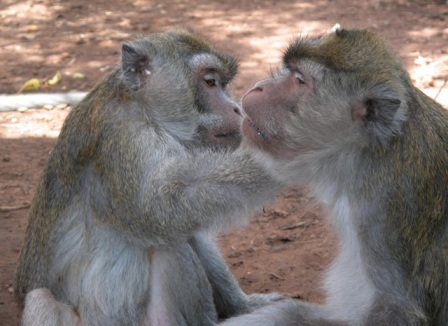Action for Primates

|
Action for Primates |

|
|
The term bushmeat refers to the meat of wild animals, including non-human primates, who have been killed for human consumption. Monkey meat has traditionally been viewed as a delicacy and is also believed to have medicinal qualities in certain parts of the world, including countries in Africa and Asia. Although it is illegal to import bushmeat into many countries, including the UK and USA, monkey meat consumption has been reported in parts of Europe and the Americas.
Non-human primate populations face many threats, such as habitat loss and fragmentation, conflicts with people, climate change, but for some species, hunting and trapping for bushmeat and medicinal products is a major negative impact on their very survival.
An article published in 2016 produced an analysis showing that bushmeat hunting for mostly food and medicinal products was creating a global crisis whereby 301 terrestrial mammal species, including non-human primates, are threatened with extinction (Ripple et al 2016).
Non-human great apes – bonobos (Pan paniscus), chimpanzees (Pan troglodytes), gorillas (Gorilla spp), orangutans (Pongo spp) – are especially vulnerable to the bushmeat trade. All theses species are listed as Threatened or Critically Threatened – one step away from becoming extinct – by the IUCN Red List of Endangered Species (IUCN 2020). According to the Pan African Sanctuary Alliance (PASA), in West Africa and the Congo Basin, bushmeat is now the leading threat to great apes and monkeys (Tworoski undated). The eastern lowland gorilla (Gorilla beringei graueri) or Grauer's gorilla, a subspecies of the eastern gorilla (Gorilla beringei), has lost 77% of its population since 1994, declining from 16,900 individuals to just 3,800 in 2015 (IUCN 2016). According to the IUCN, although the killing or capture of great apes is illegal, hunting represents the greatest threat to the eastern lowland gorilla.
Other non-human primate species for which hunting for bushmeat is a major threat, include the Celebes crested macaque (or crested black macaque, Macaca nigra) in Sulawesi, Indonesia. The species is listed as critically endangered on the IUCN Red List of Threatened Species with its population decreasing. In Sulawesi, macaque meat is a traditional food and prised by local communities (Supriatna & Andayani 2008) and was the subject of a TV news report in 2017 (Rappler Indonesia 2017).
The methods used to catch non-human primates are invariably cruel and cause much suffering and distress. The animals may be caught in traps or with the use of nets or snares. With snares, a cable or wire noose is used to trap the individual around the neck or limbs. Infants may be trafficked or sold into the pet trade, while adults are killed and sold as meat or alive to be slaughtered for consumption at wildlife markets.
In addition to the impact on the welfare and well-being of non-human primates captured or bred for the food and body part trade, close contact with these wild animals can be harmful to people, too. Human proximity to wild animals can lead to cross-species transmission of various infectious microorganisms (resulting in zoonotic disease). Animals at wildlife markets are highly stressed which means that they are more likely to shed infectious organisms, thus increasing the likelihood of spread to people. These markets can be prime locations for viruses, for example, to spread from one species to another. This can result in highly contagious outbreaks of new and deadly diseases, such as coronavirus disease 2019 (COVID-19), which may have originated in a wildlife market in Wuhan, China (Anon 2020), although there is evidence that a person already infected may have brought the virus to the market (Zhan et al 2020). Scientists have warned specifically about the danger to human health brought about as a result of the bushmeat trade:
It is now widely accepted that a frequent mechanism of pathogen transmission from non-human primates to humans is through the hunting and butchering of non-human primates because of the broad range of fluids and tissue types hunters and butchers come in contact with.(Locatelli & Peeters 2012)
Trophy hunting: This is the hunting and killing of wild animals for entertainment and pleasure. It is a booming industry, with hunters paying great sums of money to kill animals, including endangered species such as elephants, lions and rhinos. It is a cruel and immoral activity – animals may even be hunted with bows and arrows, causing injury and prolonged suffering. The hunter keeps a body part of the animal – such as heads, skulls or skin – as a 'trophy' to be mounted on a wall or otherwise put on display.
Non-human primates are also a target of the trophy hunters, and a recent analysis of data by Humane Society International found that between 2007 and 2016, 11,205 non-human primate hunting trophies were traded internationally (Maron 2018). Almost 80% (8,896) were imported into the USA. The most hunted non-human primate species was the chacma baboon (Papio ursinus), followed by grivet monkeys (Chlorocebus aethiops), yellow baboons (Papio hamadryas cynocephalus) and olive baboons (Papio anubis). The hunting took place mostly in Mozambique, Namibia, South Africa, Zambia and Zimbabwe.
![]()
![]()
![]()
![]()
![]()
Contact us via E-mail
Copyright © 2020-2026 Action for Primates. All rights reserved.